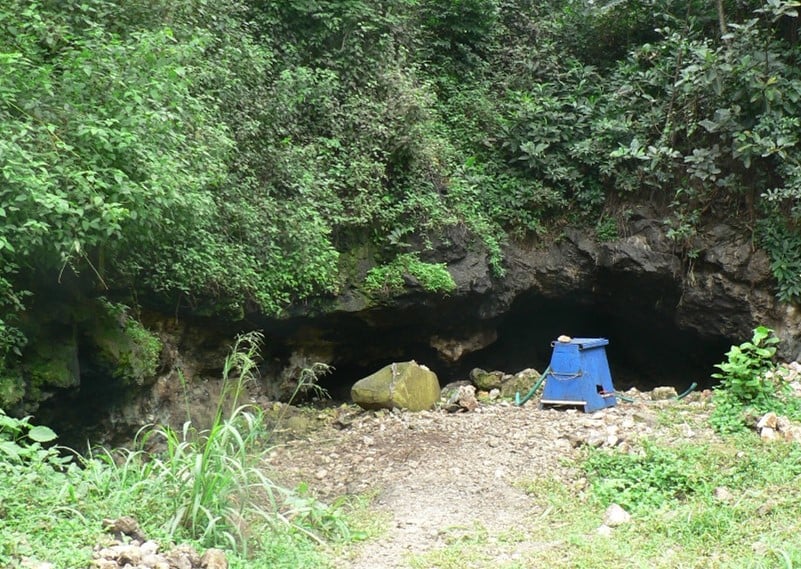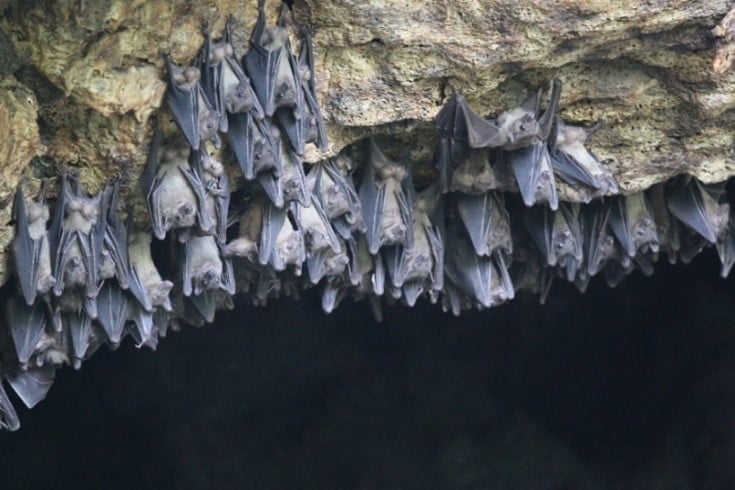Abstract
Marburg virus, the first filovirus discovered and a close cousin to the Ebola virus, is carried by the Egyptian rousette bat, a common cave-dwelling fruit bat endemic to sub-Saharan Africa whose populations can exceed 50 000 individuals. Community outbreaks of Marburg virus can result in high morbidity rates. In eastern Africa, favorite habitats of these bats include rural subterranean gold mines—sometimes worked illegally—that create environments conducive to zoonotic virus transmission. This commentary on a case describes how outbreaks of Marburg virus disease among people exposed to sub-Saharan African caves and mines containing these bats cause tensions among miners, companies, public health officials, and conservationists.
Case
In July 2007, 3 artisanal gold miners working in an African mine were diagnosed with Marburg virus disease (MVD),1 a rare, often fatal hemorrhagic disease in humans caused by either Marburg virus (MARV) or Ravn virus (RAVV), the 2 marburgviruses in the genus Marburgvirus.2 In past outbreaks of MVD involving multiple persons, case fatality ratios ranged from 23% (32 cases) to 90% (252 cases) and were typically propagated by human-to-human and nosocomial transmission (particularly through unsafe injection practices) following an initial spillover from the natural animal reservoir.3 Soon after the outbreak was declared, the nation’s health ministry, working with local district government administration, closed the mine indefinitely. Within weeks, a multinational team of disease ecologists, scientists, and conservationists, including experts from the host country, arrived to survey the fauna, primarily bats, where the miners had been working.
A months-long investigation identified the cave-dwelling Egyptian rousette bat (ERB) as the marburgvirus natural reservoir after the multinational team isolated both MARV and RAVV directly from ERB tissues and found that over 5% of the bats were actively infected.4 Just after the ecology team departed—but while the mine was still closed—a local miner surreptitiously reentered the mine seeking gold and became nonfatally infected with RAVV. There were no further human infections resulting from this second spillover event.
For the next 9 months, the mine remained closed, with no clear plan for risk mitigation and no monetary compensation for local workers. The same disease ecology team returned to the mine the following May to inform local authorities of their initial findings and to conduct follow-up studies of the bats. At the mine, the team was met by agitated workers wanting to know when they could reenter the mine and resume their work. One miner pointedly asked why they were being “kept from their riches.”
District health authorities and miners were informed that the ERBs were the source of infection and that, as long as the bats were present, the risk of contracting MVD would remain. They were also told that the bats should not be exterminated because they would likely return and that, without proper personal protective equipment—a costly and unsustainable investment for a local miner—workers could become infected. Miners and authorities were also told that the bats were vital to the ecosystem for seed dispersal and pollination, both of which are natural fruit bat activities vital to regional food production. During the following months, an extermination effort was nevertheless initiated by blocking egress from the cave with papyrus reed barriers and by restricting cave exits and capturing bats in fishing nets. As a result, bundles of dead and dying bats were discarded in a nearby forest, and shortly thereafter, no visible evidence of living ERBs remained in the mine.5
For the next 3 years, the mine was not monitored until an MVD outbreak emerged in a town within 20 km of the mine.6 An investigative team returned to the mine and found that the papyrus reed barriers had long since disintegrated, the ERBs had returned, and there was clear evidence of renewed human activity inside the mine. Subsequent ecological studies found that the overall prevalence of active marburgvirus infection in the ERB population had surged to almost 3 times what it was previously.5
It was speculated that, after the initial bat culling, an immunologically naïve ERB population built up over time and marburgvirus was reintroduced and spread rapidly in the bat colony. The primary human case was never confirmed, but epidemiological investigations, combined with a spike in marburgvirus circulation levels in the bats, suggested renewed mining activity in the presence of ERBs as the most likely source of the outbreak.5,6
Commentary
This scenario involving rural African gold and other artisanal miners working in close proximity to bats known to carry high-consequence zoonotic pathogens highlights numerous ethically complex questions faced by public health professionals, wildlife conservation authorities, and workers with limited skill sets living in or near poverty.
One challenge is that mining gold and other minerals in remote areas of Africa (see Figure 1) offers an economic lifeline to local workers, with an additional lure of substantial monetary gain if significant gold deposits are found. A straightforward, although probably unrealistic, remedy to zoonotic disease transmission is to persuade miners to choose a different livelihood. But employment is limited in rural settings in many parts of Africa. Furthermore, some miners reported to us during our investigations that they had been working in the mine for many months or even years without knowingly contracting MVD. These reports suggested their belief that getting infected is not likely or that the virus is not real. It does not help that authorities charged with promoting public health or protecting wildlife are often spread thin and poorly resourced.
Figure 1. The Kitaka Mine in Uganda With an Air Compressor in the Foreground

© 2007 Robert Swanepoel. Reproduced with the photographer’s permission.
Exterminating the bats (see Figure 2) is also not a desirable solution for multiple reasons, primarily because mass culling to control zoonoses can make matters worse, as was shown by the marburgvirus resurgence at the Kitaka mine and by the resurgence of other bat-borne zoonotic diseases such as rabies in Peru.7 Also, bats are very long-lived for small mammals, some living over 20 years in the wild,8 and they will remember their ancestral homes if driven off and allowed to return.9
Figure 2. Egyptian Rousette Bats at Python Cave, Queen Elizabeth National Park, Uganda

© 2018 Jonathan Towner. Reproduced with the photographer’s permission.
The scenario observed at the mine in Uganda is not unique. Almost a decade earlier, in northeastern Democratic Republic of Congo, MVD emerged among gold miners and their close contacts working illegally at another mine.10 The outbreak lasted from 1998 to 2000 and was a consequence of many miners working underground with ERBs and other bats, sometimes for days at a time. Marburgviruses were detected in the bats, and genetic sequencing showed that the 2-year outbreak was really a series of multiple virus introductions followed by limited human-to-human transmission.10,11 In fact, interviews and retrospective reviews of health records at a nearby hospital suggested that small clusters of MVD cases developed as far back as 1994.10 The outbreak eventually ended when the mine flooded.10
Solutions
There are no easy answers to ethically relevant questions raised by cases like the one described. It is beyond the scope of this commentary to address some of these dilemmas, not least of which is basic food security, as ERBs and other bats are hunted for food in some regions of Africa.
Bat exclusion. A potential strategy that might be permanent is nonlethal exclusion of bats from caves using tight-fitting metal grates or other durable material. This strategy has been successful with small bats living in buildings,12 but significant investment and regular monitoring by mine operators would be needed to ensure barriers’ integrity in caves. For large commercial mining operations, nonlethal exclusion might be viable when it aligns with good corporate citizenship and helps to avoid costly litigation that could ensue from corporate failures to mitigate risks to workers from a known biological hazard.
Roost and forage site mapping. In Uganda and elsewhere, wildlife authorities are trying to identify ERB roost locations and map bats’ nocturnal forage sites relative to human habitation locales.13 Marburgviruses are shed in the saliva, urine, and feces of ERBs, and, being fruit bats, ERBs eat figs, mango, sweet banana, and papaya—foods popular among humans and other animals that ERBs could contaminate while they are feeding in the trees.3 Data obtained from roost and forage site maps can help focus and enhance MVD surveillance efforts, especially when community health volunteers and facility health care workers are targeted for training in symptom recognition. Furthermore, as marburgvirus vaccines and medical counter measures are nearing approval by the US Food and Drug Administration and the World Health Organization, some having recently completed phase I trials,14 these interventions could be made available at clinics near gold-mining communities. Infection prevention is best, but when spillover happens, rapid case identification and treatment availability are essential.
Tourist health. In addition to gold mining, tourism has been linked to spillover events. As shown in Figure 2, Queen Elizabeth National Park in Uganda is about 50 km from a mine15 and attracts tourists interested in observing its rich biodiversity, including visible ERB colonies that attract predator snakes, such as pythons and forest cobras. To curb infection among tourists, the Ugandan Wildlife Authority built an enclosed viewing platform close to the cave. For over a decade now, tourists have been successfully and safely viewing the bats and snakes, allowing the ERBs to remain a vital part of the ecosystem while still attracting much needed revenue for the national park.
Conclusion
This commentary has discussed ways in which companies and governments can pursue due diligence to mitigate ecological and human health risks posed by Marburg virus.
References
- Adjemian J, Farnon EC, Tschioko F, et al. Outbreak of Marburg hemorrhagic fever among miners in Kamwenge and Ibanda districts, Uganda, 2007. J Infect Dis. 2011;204(suppl 3):S796-S799.
- Amarasinghe GK, Ayllón MA, Bào Y, et al. Taxonomy of the order Mononegavirales: update 2019. Arch Virol. 2019;164(7):1967-1980.
-
Amman BR, Swanepoel R, Nichol ST, Towner JS. Ecology of filoviruses. Curr Top Microbiol Immunol. 2017;411:23-61.
-
Towner JS, Amman BR, Sealy TK, et al. Isolation of genetically diverse Marburg viruses from Egyptian fruit bats. PLoS Pathog. 2009;5(7):e1000536.
- Amman BR, Nyakarahuka L, McElroy AK, et al. Marburgvirus resurgence in Kitaka Mine bat population after extermination attempts, Uganda. Emerg Infect Dis. 2014;20(10):1761-1764.
- Knust B, Schafer IJ, Wamala J, et al. Multidistrict outbreak of Marburg virus disease—Uganda, 2012. J Infect Dis. 2015;212(suppl 2):S119-S128.
-
Viana M, Benavides JA, Broos A, et al. Effects of culling vampire bats on the spatial spread and spillover of rabies virus. Sci Adv. 2023;9(10):eadd7437.
-
Wilkinson GS, Adams DM. Recurrent evolution of extreme longevity in bats. Biol Lett. 2019;15(4):20180860.
-
Fenton MB. Bats navigate with cognitive maps. Science. 2020;369(6500):142.
-
Bausch DG, Nichol ST, Muyembe-Tamfum JJ, et al; International Scientific and Technical Committee for Marburg Hemorrhagic Fever Control in the Democratic Republic of the Congo. Marburg hemorrhagic fever associated with multiple genetic lineages of virus. N Engl J Med. 2006;355(9):909-919.
-
Swanepoel R, Smit SB, Rollin PE, et al; International Scientific and Technical Committee for Marburg Hemorrhagic Fever Control in the Democratic Republic of Congo. Studies of reservoir hosts for Marburg virus. Emerg Infect Dis. 2007;13(12):1847-1851.
- Porter JH, Corda K. Account of an informed bat exclusion at the Temple of Deir el-Shelwit, Luxor, Egypt. Conserv Manag Archaeol Sites. 2013;15(2):195-212.
- Amman BR, Schuh AJ, Akurut G, et al. Micro-global positioning systems for identifying nightly opportunities for Marburg virus spillover to humans by Egyptian rousette bats. Emerg Infect Dis. 2023;29(11):2238-2245.
- Hamer MJ, Houser KV, Hofstetter AR, et al. Safety, tolerability, and immunogenicity of the chimpanzee adenovirus type 3-vectored Marburgvirus (cAd3-Marburg) vaccine in healthy adults in the USA: a phase 1, open-label, dose-escalation trial. Lancet. 2023;401(10373):294-302.
-
Amman BR, Carroll SA, Reed ZD, et al. Seasonal pulses of Marburg virus circulation in juvenile Rousettus aegyptiacus bats coincide with periods of increased risk of human infection. PLoS Pathog. 2012;8(10):e1002877.



